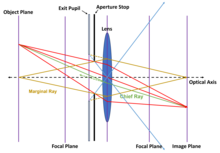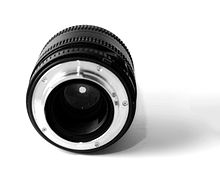In optics, the exit pupil is a virtual aperture in an optical system. Only rays which pass through this virtual aperture can exit the system. The exit pupil is the image of the aperture stop in the optics that follow it. In a telescope or compound microscope, this image is the image of the objective element(s) as produced by the eyepiece. The size and shape of this disc is crucial to the instrument's performance, because the observer's eye can see light only if it passes through the aperture. The term exit pupil is also sometimes used to refer to the diameter of the virtual aperture. Older literature on optics sometimes refers to the exit pupil as the Ramsden disc, named after English instrument-maker Jesse Ramsden.


Visual instruments
editTo use an optical instrument, the entrance pupil of the viewer's eye (the image of the anatomical pupil as seen through the cornea) must be aligned with and be of similar size to the instrument's exit pupil. This configuration properly couples the optical system to the eye and avoids vignetting because the eye captures all of the rays exiting the instrument. The location of the exit pupil thus determines the eye relief of an eyepiece. Good eyepiece designs produce an exit pupil of diameter approximating the eye's apparent pupil diameter and located about 20 mm away from the last surface of the eyepiece for the viewer's comfort. If the disc is larger than the eye's pupil, then light will be lost instead of entering the eye. If the disc is too close to the last surface of the eyepiece, then the eye will have to be uncomfortably close for viewing; if too far away, then the observer will have difficulty maintaining the eye's alignment with the disc because there is no instrumental help to physically hold the eye position.
| Average human eye pupil diameter vs. age | ||
|---|---|---|
| Age (years) |
Day (mm) |
Night (mm) |
| 20 | 4.7 | 8 |
| 30 | 4.3 | 7 |
| 40 | 3.9 | 6 |
| 50 | 3.5 | 5 |
| 60 | 3.1 | 4.1 |
| 70 | 2.7 | 3.2 |
| 80 | 2.3 | 2.5 |
Since the eye's pupil varies in diameter with viewing conditions, the ideal exit pupil diameter depends on the application.[1] An astronomical telescope requires a large exit pupil because it is designed to be used for looking at dim objects at night, while a microscope will require a much smaller exit pupil since an object being observed will be brightly illuminated. A set of 7×50 binoculars has an exit pupil just over 7.14 mm, which corresponds to the average pupil size of a youthful dark-adapted human eye in circumstances with no extraneous light. The emergent light at the eyepiece then fills the eye's pupil, meaning no loss of brightness at night due to using such binoculars (assuming perfect transmission). In daylight, when the eye's pupil is only 4 mm in diameter, over half the light will be blocked by the iris and will not reach the retina. However, the loss of light in the daytime is generally not a concern since there is so much light to start with. By contrast, 8×30 binoculars, often sold with emphasis on their compactness, have an exit pupil of only 3.75 mm. That is sufficient to fill a typical daytime eye pupil, making these binoculars better suited to daytime than night-time use. The maximum pupil size of a human eye is typically 5–9 mm for individuals below 25 years old and decreases slowly with age as shown as an approximate guide in the table here.[2][3][4][5]
The optimum eye relief distance also varies with application. For example, a rifle scope needs a very long eye relief to prevent recoil from causing it to strike the observer.[1]
The exit pupil can be visualized by focusing the instrument on a bright, nondescript field, and holding a white card up to the eyepiece. This projects a disc of light onto the card. By moving the card closer to or further away from the eyepiece, the disc of light will be minimized when the card is at the exit pupil, and the bright disc then shows the diameter of the pupil. A clear vial of milky fluid can be used to scatter light rays exiting the eyepiece, making their paths visible. These rays appear as an hourglass shape converging and diverging as they exit the eyepiece, with the smallest cross-section (the waist of the hourglass shape) representing the exit pupil.
Telescopes
editFor a telescope, the diameter of the exit pupil can be calculated by dividing the focal length of the eyepiece by the focal ratio (f-number) of the telescope. In all but the cheapest telescopes, the eyepieces are interchangeable, and for this reason, the magnification is not written on the scope, as it will change with different eyepieces. Instead, the f-number f = L / D of the telescope is typically written on the scope, as well as the objective diameter D and focal length L. The individual eyepieces have their focal lengths written on them as well.
In the case of binoculars however, the two eyepieces are usually permanently attached, and the magnification and objective diameter (in mm) is typically written on the binoculars in the form, e.g., 7×50. In that case, the exit pupil can be easily calculated as the diameter of the objective lens divided by the magnification. The two formulas are of course equivalent and it is simply a matter of which information one starts with as to which formula to use.
Photography
editThe distance of the exit pupil from the sensor plane determines the range of angles of incidence that light will make with the sensor. Digital image sensors often have a limited range of angles over which they will efficiently accept light, especially those that use microlenses to increase their sensitivity.[6] The closer the exit pupil to the focal plane, the higher the angles of incidence at the extreme edges of the field. This can lead to pixel vignetting. For this reason, many small digital cameras (such as those found in cell phones) are image-space telecentric, so that the chief rays strike the image sensor at normal incidence.[citation needed]
See also
editReferences
edit- ^ a b Hecht (1987), p. 152.
- ^ "Aging Eyes and Pupil Size". Archived from the original on 2013-10-23. Retrieved 2009-05-19.
- ^ Factors Affecting Light-Adapted Pupil Size in Normal Human Subjects
- ^ Ortiz, Estefan; Bowyer, Kevin W.; Flynn, Patrick J. (2013). "A linear regression analysis of the effects of age related pupil dilation change in iris biometrics" (PDF). 2013 IEEE Sixth International Conference on Biometrics: Theory, Applications and Systems (BTAS). pp. 1–6. doi:10.1109/BTAS.2013.6712687. ISBN 978-1-4799-0527-0. S2CID 14118454. Archived from the original (PDF) on 2014-10-06.
- ^ "Astronomics - Outdoor Scientific & Astronomical Gear". Archived from the original on 2016-03-04. Retrieved 2016-10-05.
- ^ Wisniewski, Joseph S. (December 6, 2003). "The Digital Lens FAQ". Archived from the original on July 5, 2008. Retrieved May 11, 2008.
- Greivenkamp, John E. (2004). Field Guide to Geometrical Optics. SPIE Field Guides vol. FG01. SPIE. ISBN 0-8194-5294-7.
- Hecht, Eugene (1987). Optics (2nd ed.). Addison Wesley. ISBN 0-201-11609-X.